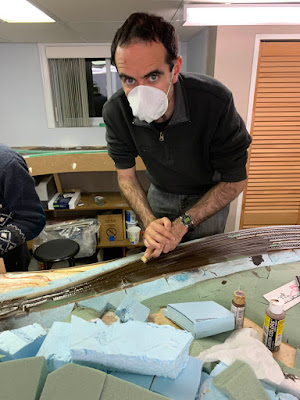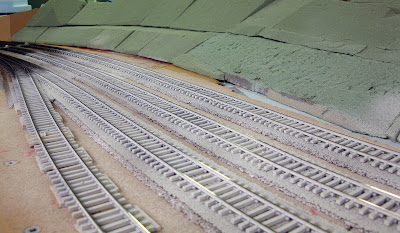First, tracks are primed in white. To make sure primer will stick during the next step, it is let to dry and cure for about a week.
Then, ties are completely masked with 1/4" tape, leaving only the rails and tie plates visible. When done, a coat of Krylon camouflage brown is sprayed over and the tape removed.
 |
| Mask and ventilation required! |
Unfortunately for us, it seems our tape was a little bit old and not that much sticky. In some areas, the tape lift and overspray happened. Also, some white primer on ties did lift up.
With a small brush and white paint, I touched up every annoying brown spots until I was satisfied.
 |
| Jérôme cleaning up the track... A crucial step! |
Jérôme, using MDF blocks and very fine grit sand paper cleaned and polished the rail heads. To make sure we didn't miss any spot, we took our most capricious locomotive - a Rapido 6-axle GMD-1 - and ran it over very piece of track at step 1. Quite slow is you ask me, but only a crawling engine can track every issue with trackwork.
Now, all this paint will be left to dry another week before we apply several oil paint washes to create a convincing weathered wood effect. This step is really worth all the efforts!
Meanwhile, Louis-Marie have been working hard on the topography. He did a terrific job and with minimal sanding, we now have realistic rolling hills and a nice set of streets. Still a lot of work ahead, but the most complicated areas are now done and ready for scenery.
Speaking of scenery, we started to fill all the gaps in scenery with mud (Celluclay + water + flat latex paint). Can't wait to ballast and add vegetation. I'm growing tired of seing plywood and foam. It's time to bring back some life to the layout!




